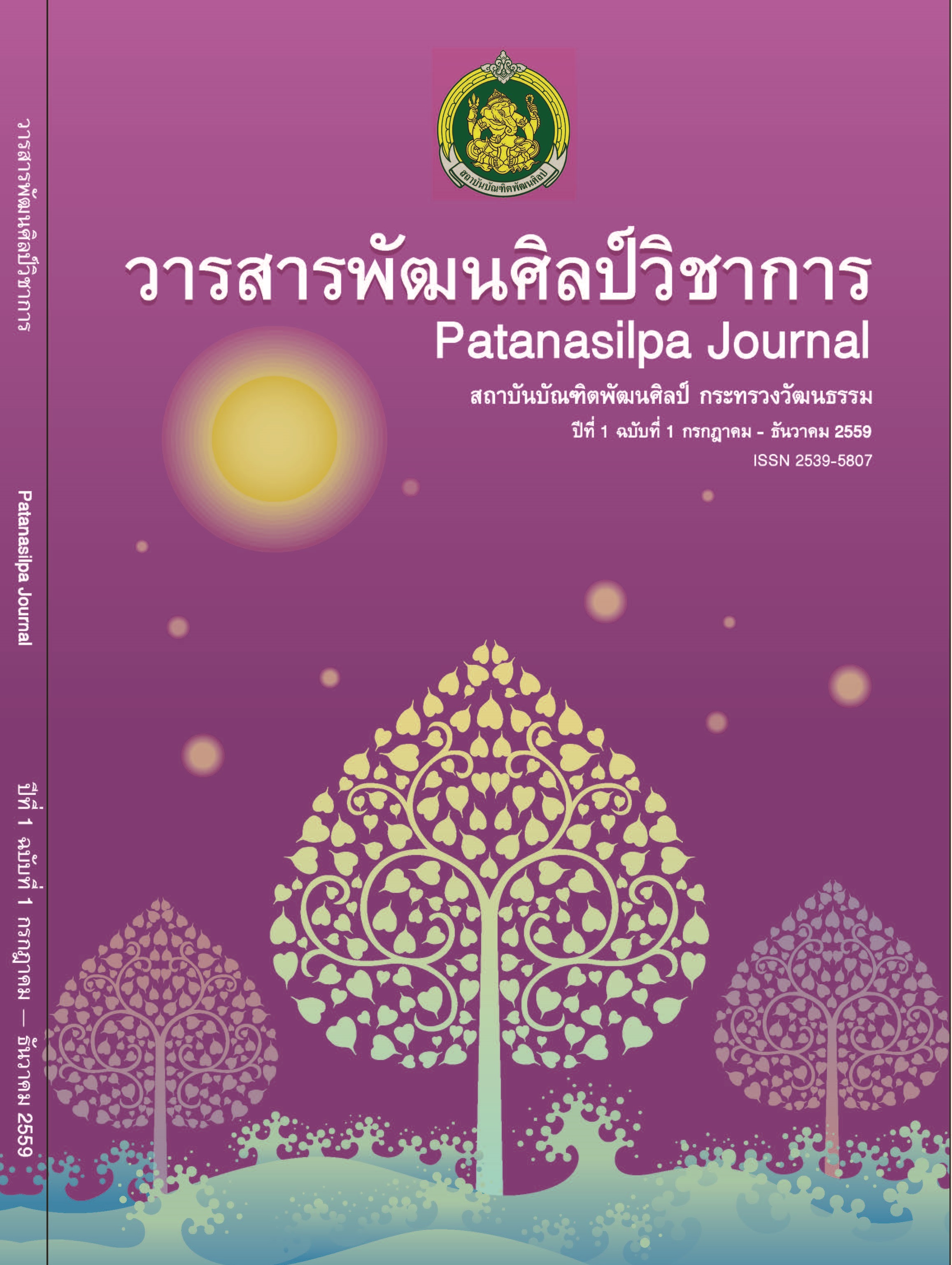PUBLIC CULTURAL MANPOWER PLANNING FOR DRAMATIC ARTS, MUSIC AND VISUAL ARTS PROGRAMS IN THAILAND 2557 TO 2559 (BE)
Keywords:
Manpower planning, Public Sectors, Faculty of Dramatic Arts Faculty of Music, Faculty of Visual Arts, Thailand of 2557 to 2559 (BE)Abstract
The purposes of this research were (1) to examine public manpower required for cultural dramatic arts in faculties of Dramatic Arts, Music and Visual Arts in 2556 (BE), (2) to study the cultural manpower plan of public sectors for dramatic arts in faculties of Dramatic Arts, Music, Composers Arts and Visual Arts in from 2557 to 2559 (BE) in Thailand
The data were collected from a sample group of 1000 people who worked in the offices of Higher Education Commission, Basic Education Commission, Vocational Education Commission, Teacher Civil Service and Educational Personnel Commission and Private Education Commission, public and private universities, Pattaya City, Ministry of Interior and Ministry of Culture from the four regions: northern, central, northeastern and southern parts.
The results showed that in 2556 (BE) there were 25,432 officers for dramatic arts in faculties of Dramatic Arts, Music and Visual Arts from the population of 64,623,000 people. The population increased from 66,000,000 people in 2557 (BE) to 68,000,000 people in 2558 (BE) and it was estimated that there would be 70,000,000 in 2559 (BE). Therefore, the increasing demand for personnel in art and culture should be correlated with the growth of the population so as to have the potential for producing teachers, researchers and educators in cultural and dramatic arts.
References
สำนักงาน ก.พ. กองวิชาการ. (2555). คู่มือการวางแผนและบริหารกำลังคน, กรุงเทพฯ: ธีรานุสรณ์การพิมพ์.
สำนัก ก.พ. ฝ่ายเลขานุการ. (2555). ยุทธศาสตร์การปรับกำลังคนภาครัฐ (2555-2560) และแนวทางปฏิบัติ, กรุงเทพฯ.
ฉัตรทิพย์ นาถสุภา. (2548). แนวทางและวิธีวิจัยสังคมไทย. กรุงเทพฯ: สร้างสรรค์.
จำนง สมประสงค์ และประดิษฐ์ ชาสมบัติ. (2519). เศรษฐศาสตร์แรงงาน. กรุงเทพฯ: ไทยวัฒนาพานิช.
จุฑา มนัสไพบูลย์. (2537). การวิเคราะห์ตลาดแรงงาน: แนวคิดเชิงทฤษฎี. กรุงเทพฯ: จุฬาลงกรณ์มหาวิทยาลัย.
จุฑารัตน์ เอื้ออำนวย. (2541). ทิศทางการวางแผนกำลังคนเพื่อรองรับการอำนวยความยุติธรรมในทิศวรรษหน้า.
เทียนฉาย กีระนันทน์. (2519). เศรษฐศาสตร์: ทรัพยากรมนุษย์และกำลังคน. กรุงเทพฯ: ไทยวัฒนาพานิช.
อมรทิพย์ แท้เที่ยงธรรม. (2544). เศรษฐศาสตร์มหภาค. กรุงเทพฯ: มหาวิทยาลัยเกษตรศาสตร์.
Meyer, Gregg S. Gastroenterology workforce modeling, JAMA. 276 (1996): 689-694. Sharif, Mohammed. Inverted “S” the complete neoclassical labor-supply function.International Labor Review. 139 (2000): 409-435.
Wetzel; O’ Toole and Perterson. An analysis of student enrollment demand. Economics of Education Review. (1998): 47-54, อ้างถึงใน นงลักษณ์ วิรัชชัย สุวิมล ว่องวาณิชและอวยพร เรืองตระกูล, 2546. หน้า 31.
Quinn, R. and Price, J.. The demand for medical education: an augmented human
capital approach. Economics of Education Review. (1998): 337-347, อ้างถึงใน นงลักษณ์ วิรัชชัย สุวิมล ว่องวาณิช และอวยพร เรืองตระกูล, 2546. หน้า 38.
Kerlinger,F.N.,and Lee,H.B. 2000. Foundations of Behavioral Research.4th edition.U.S.A.:Thomson Learning,Inc.
Kumar,R. 1996. Research Methodology. London: Sage Publications.
Yamane, Taro. 1973. Statistics an introductory analysis. (3rd ed.). New York.
Downloads
Published
Issue
Section
License
บทความที่ได้รับการตีพิมพ์เป็นลิขสิทธิ์ของ สบศ.





